17-2 Plant Structures and Responses
Plants without vascular tissue are limited in size and complexity. Mosses and other nonvascular plants must have water close to their entire bodies to maintain homeostasis. Vascular plants are much more complex and have specialized structures and adaptations. In order to achieve a larger biomass, vascular plants have organs that help collect the materials required for photosynthesis.
Plant Cells and Tissues
The cells of vascular plants are organized into three main tissue types: dermal, ground, and vascular.
Dermal Tissue The epidermis is a protective covering on the outside of plants that consists of a single layer of tightly packed cells. In older woody plants, layers of cork cells occur on the outsides of stems and roots. These box-like cells are stacked in columns. The cell walls of both epidermis and cork are coated with wax to keep the cells from drying out. Water vapor, oxygen, and carbon dioxide can enter and leave the plant through small holes present in the tissue layers.
Ground Tissue Beneath the epidermis, ground tissue fills up most of the volume within the plant. Most ground tissue cells have fabric-like cell walls. Some cells of ground tissue are dead when mature. These cells have modified cell walls that contain lignin, a strong macromolecule that makes the cells woody and rigid (Figure 17-9). These cells provide bone-like support to the plant.
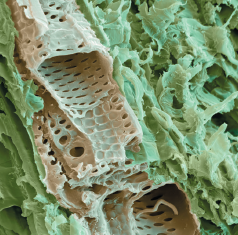
▲ FIGURE 17–9 A scanning electron micrograph of a bamboo xylem vessel (125× magnification); the cell walls contain lignin (gray) that support the plant.
Vascular Tissue There are two types of vascular tissue: xylem and phloem. Xylem consists of hollow pipes made of lignin-containing cells that transport water and dissolved minerals up from the roots and provide support. When mature, the cells of the xylem are dead and hollow. Fluid moves through the space where cytoplasm used to be.
Phloem transports sugars and other products of photosynthesis. It can move materials down from the leaves or up from the roots to supply all parts of the plant. Phloem is made of living cells that use active transport to pass sugars from cell to cell. Phloem is made up of two cell types, sieve cells and companion cells. Sieve cells are long and lack nuclei. They carry sugars from one end of the cell to the other. Lying next to the sieve cells are short-nucleated companion cells. The nuclei of companion cells control the function of the neighboring sieve cells.
Xylem and phloem form strands called vascular bundles that run the length of the plant. Xylem is located toward the center of the bundle and is surrounded by phloem. For example, trees and shrubs grow thick cylinders of xylem in the center of the stems, covered by a thin outer layer of phloem. Vascular tissue fills the volume of woody stems and roots. In leaves, the vascular bundles are referred to as veins. In leaves and non-woody stems, vascular bundles are surrounded and supported by both living ground tissue and dead vascular tissue.
? Where would you expect to fi nd ground tissue in a pine tree?
Plant Structures
To make their own food, plants require light, water, and carbon dioxide. Vascular plants have three basic organs to bring these ingredients together with their photosynthesis machinery: roots, stems, and leaves. All three organs are made of the same cell and tissue types.
Roots To absorb water efficiently from soil, roots have finger-like extensions called root hairs that penetrate the spaces between soil particles. The vascular tissue in the center of the root is surrounded by a thick layer of ground tissue called the root cortex that serves as a starch storage area (Figure 17-10). When water moves through the cortex to the outer edge of vascular tissue, the innermost layer uses energy to keep excess salts and toxins out of the cell and let water in. Once inside the xylem, water can be transported up the root, into the stems and leaves.
Root Anatomy
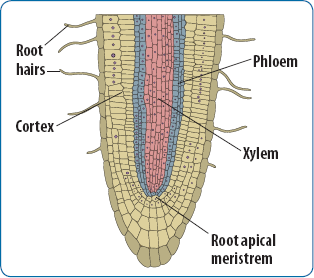
▲ FIGURE 17–10 The root apical meristem is the site of new growth that extends the root downward into the ground.
There are two basic root systems: taproots and fibrous roots (Figure 17-11). In most gymnosperms and dicots, the embryonic root in the seed extends during germination. This is the taproot, a thickened root in the center of the system. All other roots branch from here.
Root Systems

▲ FIGURE 17–11 Most gymnosperms and dicots have taproots. Most monocots and ferns have fibrous roots.
Taproots provide an anchor for plants and can grow deep into the ground, stabilizing the plant against wind and shifting soil. Taproots also store starch that can be used to promote flowering or produce seeds. Carrots and beetroot are both examples of edible taproots. Deep taproots provide protection against drying out, especially in areas that are prone to drought. Many desert plants have taproots, some of which can extend up to 30 m (100 ft) underground. The visible parts of the plant can be quite small, as much of the plant’s energy is put toward growing the root.
In monocots and pteridophytes, the embryonic root fails to dominate root growth. Instead, a tangle of numerous fine roots, called fibrous roots, grow. Fibrous root systems have greater surface area to absorb water and nutrients. This allows plants to grow quickly in a single season. For example, corn has a fibrous root system and is able to grow from a seedling to over 2.3 m (7.5 ft) tall in a single season. Plants with fibrous roots tend not to be as drought-resistant as those with taproots.
Plants can also grow adventitious roots, which grow from a plant part other than the root. These may be part of the normal plant life cycle. For example, strawberry plants form “runners,” which are adventitious roots that come off the stem. The runners grow along the ground and develop into new plant bodies. Adventitious roots can also grow in response to stress. Flooding, damage to the root system, or nutrient-poor soil can encourage adventitious root formation.
Stems Some pteridophytes have a central core of vascular tissue, while some ferns, gymnosperms, and angiosperms have ground tissue called pith in the central core of the stem. Outside the pith are vascular bundles, which are then surrounded by cortex. In gymnosperm and dicot stems, the vascular bundles are arranged in a single circle. In monocots, there are many vascular bundles scattered throughout the cortex (Figure 17-12).
Stem Anatomy

▲ FIGURE 17–12 Vascular bundles are made of xylem and phloem vessels that carry water and nutrients to other plant parts.
Leaves The organ primarily responsible for photosynthesis in plants is the leaf (Figure 17-13). Leaves are usually flat and are covered by a waxy waterproof layer called the cuticle. Chlorophyll-containing ground tissue is sandwiched between the epidermal layers. In the lower epidermis, openings called stomata (singular stoma) are present. Guard cells form the “lips” around each stoma. When guard cells lose water, they collapse, closing the stoma, preventing excess water loss and providing protection against wilt. When open, stomata allow carbon dioxide to enter the leaf, while water vapor and oxygen diffuse out. Stomata and guard cells play essential roles in gathering the reactants of photosynthesis and maintaining homeostasis by preventing water loss.
Leaf Anatomy
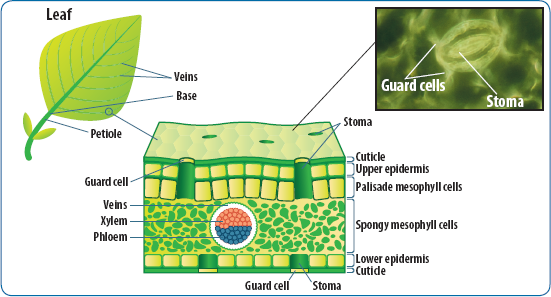
▲ FIGURE 17–13 Anatomy of a leaf
The upper half of leaf ground tissue consists of long, tightly packed cells with many chloroplasts, called palisade mesophyll. The chloroplasts harvest sunlight for photosynthesis. Below the palisade mesophyll is a layer of cells called spongy mesophyll. These cells are rounded and loosely packed with few chloroplasts. The spaces between spongy mesophyll cells allow water, oxygen, and carbon dioxide to flow between the stomata and the palisade mesophyll.
stoma
stoma = mouth
Between the upper and lower ground tissue layers, vascular bundles called veins form a strong mesh, stiffening the leaf. These bundles transport water and nutrients throughout the plant.
The leaves of plants can be specially adapted to the plant’s habitat. For example, many conifers grow well in cold environments. The leaves of these trees are reduced and needle-like. The small surface area reduces the amount of water lost through stomata. Reduced leaves are also less appealing to insects and animals as food. In tropical rain forests, leaves have drip tips that allow water to drain off the leaves quickly. This is important for preventing fungal and bacterial growth on the plant.
conifer
conus = cone
fer = bearer
Plant Growth
The cells of vascular plant embryos are small and packed with cytoplasm. As the embryo grows, the cells differentiate into specialized cells. The tips of the stem and root remain a cluster of pluripotent stem cells, in an area called the apical meristem, that allows the stems and roots to enlarge.
As roots and stems grow, the apical meristems are pushed farther away from the center. Along the stem, some cells divide faster, forming side bumps called nodes. The nodes are dormant meristems that will only become active if chemical signals are received that activate growth.
Stems and roots of dicots and gymnosperms can also increase in width. These plants have lateral meristems, thin layers of undifferentiated cells that divide and specialize, adding thickness. A lateral meristem called the vascular cambium sits between the xylem and phloem. When woody growth begins, the vascular cambium produces xylem cells toward the inside, making a solid core called wood that increases in diameter (Figure 17-14). The vascular cambium also produces small amounts of phloem toward the outside. Some of the phloem and cortex cells divide to form a lateral meristem called the cork cambium. This meristem generates cork cell layers. Together, the old phloem and cork make up bark, which replaces the cortex and epidermis on woody stems and roots.
Lateral Meristem

▲ FIGURE 17–14 Plants with lateral meristems will increase in width as well as height.
? What would happen to a plant if the apical meristem were removed?
▶ FIND OUT WHY
Apical meristems are controlled by plant hormones. Find out what hormones are involved in maintaining apical dominance. How does pruning trees affect the meristems and nodes of a tree?
![]() EXPAND YOUR KNOWLEDGE K17–3
EXPAND YOUR KNOWLEDGE K17–3
Vegetative Reproduction
The quaking aspen is a medium-sized tree with an interesting reproductive strategy. Aspens are able to colonize disturbed areas during secondary succession, yet their seeds are not robust and seedlings rarely survive. How are these trees one of the most successful species in North America?
Quaking aspens can reproduce through a process called vegetative reproduction, where shoots sprout from the root system, growing into clones. All the trees that develop are genetically identical and share a common root system. Vegetative reproduction is stimulated by sunlight. When a clone in the stand of trees dies, it creates a hole in the canopy. The available sunlight stimulates chemical messages that tell the roots to sprout and grow a new tree. Some scientists believe that the genome of the first aspen tree has been reproducing vegetatively for thousands of years.
The Pando clone in Fishlake National Forest, Utah, is a group of genetically identical quaking aspens all sharing the same root system. The stand covers more than 100 acres and weighs an estimated 6,350 metric tons, making it one of the largest organisms on Earth. Today, the Pando clone is thought to be dying. Overgrazing by animals may be the main cause of the decline. Scientists are studying the Pando clone to find ways to save this massive organism.
Plant Transport
The current theory explaining the movement of water up the tree trunk through the xylem is called the transpiration-cohesion theory. According to this theory, plants suck water up through xylem vessels like drinking through a straw. Water evaporates out of leaves in a process called transpiration, which provides the suction that pulls water up from the roots. This transports water up the trunk to the leaves. Recall that water has high cohesion (Chapter 6), and hydrogen bonding allows water molecules to stick together. Cohesion draws water up through the roots to the leaves, replacing water lost through the stomata.
Sugar molecules are moved throughout the plant by a process called translocation. Sugar is moved from the source, or the location of sugar production (leaves), to other parts of the plant, referred to as sinks, where sugar is either used or stored (Figure 17-15).
Translocation
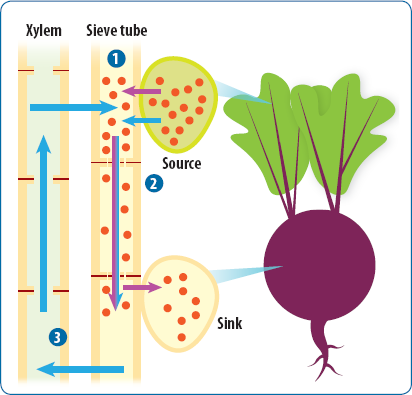
▲ FIGURE 17–15 (1) Sugar is pumped into the phloem by active transport. (2) Water then moves into the phloem by osmosis, creating positive pressure in the phloem. The pressure moves the sugars through the chain of phloem sieve cells to the sinks. (3) Sugar is unloaded in the sink cells as water diffuses out of the phloem. The pressure becomes lower in the sink area and water returns to the xylem.
Plant Responses
Like animals, plants have to respond to their environments; unlike animals, plants cannot relocate to find favorable conditions. Because plants are rooted in place, they need ways to respond to changes in the environment.
Light Beyond its role in photosynthesis, light is important in maintaining homeostasis in plants. Plants take cues from the quality and duration of daylight to determine whether to grow or go dormant and when to open or close flowers. A plant’s ability to sense the time of day and the season is called photoperiodism. Plants use this ability to initiate periods of rapid growth during long spring and summer days and go dormant during short winter days. Longer days provide more sunlight needed for growing leaves, flowers, and fruits. Plants can also detect the direction of the Sun and will grow toward the light, angling leaves to absorb the most sunlight. Movement in the direction of sunlight is called phototropism.
phototropism
photo = light
tropos = to turn
Gravity Because seeds often germinate underground where there is no light, plants must be able to detect gravity as a means of determining direction. This ability, called gravitropism, ensures that roots grow down and stems grow up. Within some plant cells are specialized organelles called amyloplasts. These plastids contain heavy starch granules that settle at the bottom of cells, indicating the downward direction.
DID YOU KNOW?
If you tip a potted plant on its side, roots will grow in the direction of the “new down” due to gravitropism.
Plant Hormones Plants produce a number of different hormones to regulate body processes and maintain homeostasis. Many of these hormones have antagonistic effects and work in tandem to ensure that the plant grows and produces fruit at appropriate times. For example, one function of auxins is to prevent leaves from aging and falling. Abscisic acid has an opposite effect and stimulates leaf falling. These hormones must be balanced and produced at the correct times to allow the plant to respond to its environment. Figure 17-16 provides a summary of some of the hormones used by plants to regulate biological processes.
FIGURE 17–16
| Plant Hormones | |
|---|---|
| Auxin | Promotes stem and root growth, inhibits branching (apical dominance), stimulates fruiting, prevents leaf falling |
| Cytokinins | Promotes root growth, stimulates germination, delays aging in leaves |
| Gibberellin | Stimulates germination, promotes stem and leaf growth, stimulates flowering and fruiting |
| Abscisic acid | Inhibits growth, closes stomata, induces dormancy during winter, maintains seeds in a dormant state |
| Ethylene | Ripens fruit, promotes root growth and leaf and flower falling |
Toxins Plants produce toxins to protect themselves against parasites, insects, and animals. These toxins can affect the biological functions of the animals that eat them and can be harmful to humans. Hydrogen cyanide, a powerful neurotoxin, is common in plants. Cassava, almonds, and lima beans all contain cyanide. Plant crops that produce cyanide must be cooked or treated in a way to remove the toxin. For example, cooking lima beans inactivates the toxin, making the crop edible. Many crops, like almonds, are selectively bred or genetically engineered to contain low levels of cyanide.
DID YOU KNOW?
Fiddleheads of some fern species can be poisonous. Cooking inactivates the toxins, making them safe to eat.
![]() EXPAND YOUR KNOWLEDGE K17–4
EXPAND YOUR KNOWLEDGE K17–4
How Do Plants Move?
Scientists once thought that, when an insect hit the trigger hairs inside the open leaves of a Venus flytrap (Dionaea muscipula) (Figure 17-17), special cells rapidly transported potassium ions out, causing water loss that collapsed and closed the “jaw” of the plant. New data suggests that there is a buildup of water pressure between different cell layers. When the trigger is hit more than once within 30 seconds, an electrical signal is sent that results in water being instantly jettisoned from the inside layer to the outside, changing the shape of the leaf and closing it. Why do you think the trigger hairs have to be hit twice for the flytrap to close?
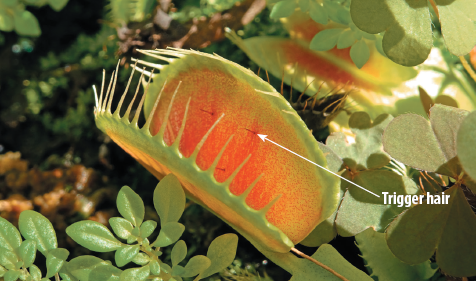
▲ FIGURE 17–17 Trigger hairs on the Venus flytrap cause the leaves to close.
LESSON 17-2 REVIEW
What is an apical meristem?
List at least three plant responses to environmental stimuli.
How does the structure of wood cells provide strength to the plant?
Why do plants produce toxins?
Think About It
Why do you think that leaves and roots are nutritious food sources and stems are not? How does the cellular structure of each plant part explain this?
Does sap in maple trees travel through xylem or phloem? What are the source and the sink? What would happen if you removed all the sap from a maple tree?
Find Out Why
Grass lawns can be mowed many times without killing the plant, an activity that would kill most other types of plants. Conduct research to find out how grass continues to grow after being cut.
Research a plant toxin that is important in human medicine and detail how it is used. What is the toxin’s function in the plant, and how do we use this for our benefit?
See your Student Lab Manual to complete Lab 17-2.